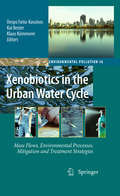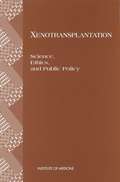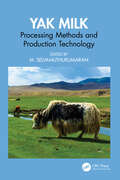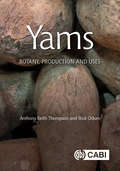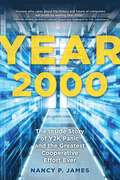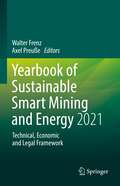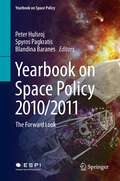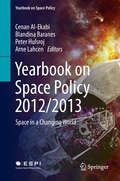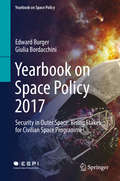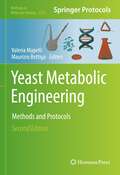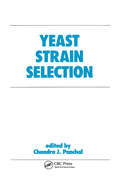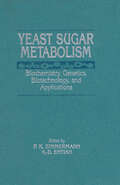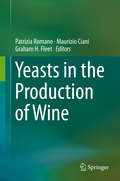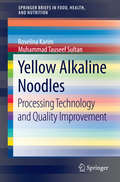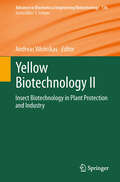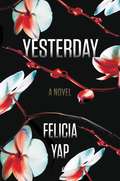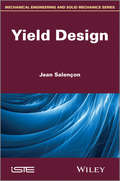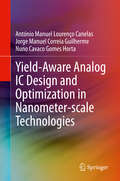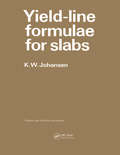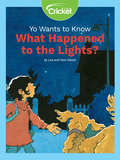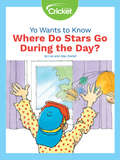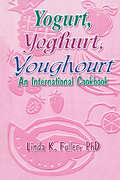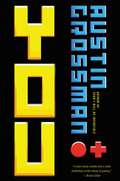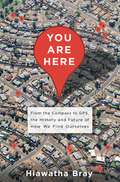- Table View
- List View
Xenobiotics in the Urban Water Cycle
by Klaus Kümmerer Despo Fatta-Kassinos Kai BesterThe presence of xenobiotics in the aquatic environment is seen as one of the biggest challenges for a sustainable water future. Thus, there is a need to understand, in an integrated manner, the sources, flow paths, fate and effects of xenobiotics in the urban water cycle. This book is an authoritative and comprehensive reference source covering: occurrence, sources and fluxes of xenobiotics in urban waters, processes concerning the fate and transport of xenobiotics, mass flows and transformation products, mitigation, treatment methods and systems for the removal of xenobiotics, risk assessment methodologies and risk management, information on source control and mitigation measures. The book contains a wealth of information on some of the compounds most frequently found in urban water systems, and of special interest will be the chapters dealing with compounds that have only recently been investigated, such as illicit drugs, scents, and toxins.
Xenotransplantation: Science, Ethics, and Public Policy
by Public Policy Committee on Xenograft Transplantation: Ethical IssuesXenotransplantation involves the transplantation of cells, tissues, and whole organs from one species to another. Interest in animal-to-human xenotransplants has been spurred by the continuing shortage of donated human organs and by advances in knowledge concerning the biology of organ and tissue rejection. The scientific advances and promise, however, raise complex questions that must be addressed.This book considers the scientific and medical feasibility of xenotransplantation and explores the ethical and public policy issues surrounding the possibility of renewed clinical trials. The volume focuses on the science base of xenotransplantation, public health risks of infectious disease transmission, and ethical and public policy issues, including the views of patients and their families.
Yak Milk: Processing Methods and Production Technology
by M. SelvamuthukumaranThe domestic yak (Bos grunniens), a species of long-haired domestic cattle, is found in India, Nepal, China, Pakistan, Mongolia, Russia, and Serbia. The milk derived from yaks has great nutritional potential, with protein of 4.8–5.9%, fat of 5.6–7.5%, and total solids of 17.0–17.9% in comparison with the milk from other bovine animals. This book describes various processed products derived from yak milk, such as cream, butter, ghee, yoghurt, and milk powder. It explains techniques used for the extraction of bioactive constituents from yak milk. This book also addresses various packaging and quality assurance issues of various products derived from yak.Key Features: Characterizes the composition of milk obtained from different yak species Reviews indigenous processing tactics for yak milk Addresses various packaging and quality assurance issues of various products derived out of yak
Yams: Botany, Production and Uses (Botany, Production and Uses)
by Anthony Keith Thompson Professor Ibok OduroDioscorea species, commonly known as yams, are tuberous plants that constitute a major staple food in many parts of Africa, South East Asia, Latin America and the South Pacific. Yams are cultivated in about 50 mainly tropical countries, and the world annual production of edible tubers is around 73 million tonnes. This book evaluates the current state of knowledge about yams, and how this knowledge affects practices in production, cultivation and postharvest technology. Dioscorea is a diverse genus in terms of its geographical origin, domestication, morphology, chemistry and breeding. Therefore, besides concentrating on the dozen or so species that are used as major food crops, the book examines species that have limited commercial or domestic value at present, but have the potential in future to contribute to the production and utilization of this crop. This book: · Covers botany, taxonomy, composition, uses, cultivation, handling, storage, diseases, pests and production. · Describes the yam industry in the main producer countries, and around 100 of the most commonly grown species. · Reviews many Dioscorea species that may be developed in the future. It is an essential resource for researchers in horticulture, yam growers, breeders and postharvest technologists.
Year 2000: The Inside Story of Y2K Panic and the Greatest Cooperative Effort Ever
by Nancy P. JamesCan you imagine Congress compromising, or a president signing a bill against their donors' interests? Year 2000: The Inside Story of Y2K Panic and the Greatest Cooperative Effort Ever tells how the Y2K crisis—when date-sensitive software risked crashing vital systems—was averted through unprecedented cooperation. Author Nancy James describes how the crisis was exposed, analyzed, and resolved, offering a fascinating look at teamwork on every level, along with surprising blunders and near disasters. This compelling history shows a nation united to solve a universal challenge—a timely lesson for today.The new millennium. The Year 2000. Beyond Mayan prophecies, a more immediate danger loomed: Two-digit year date fields had been used by software programmers for decades to conserve expensive computer storage space. As a consequence, legacy systems reading &“00&” on January 1, 2000 would most probably interpret the date as 1900. Infrastructures critical to civilization—including heat, electricity, water and sanitation—were at risk, all complete unknowns. There was fear of an accidental nuclear arms deployment. There was fear of monetary systems being jeopardized, infrastructure collapse, internet security failures, and interruption of government-provided social programs. Banks experienced massive cash withdrawals while law firms worked overtime to develop novel litigation plans. Insurance enterprises worried. Year 2000: The Inside Story of Y2K Panic shares the untold story of the actors operating on the global stage responsible for managing computer hardware and software for Year 2000 compliance, thus keeping national infrastructures, finance, and commerce functioning. It turned out that the world did not end January 1, 2000. In fact, most people rang in the new year with the perception that nothing happened at all. This positive outcome was not a stroke of luck, nor was it because people overestimated or exaggerated Y2K risk. It was only possible because people across industries, from legal clerks to programmers to President Bill Clinton himself, worked tirelessly to offset disaster. But the Millennium did not pass completely harmlessly: it turns out that the United States, for a brief period, lost all satellite reconnaissance at 7:00 PM EST, December 31, 1999 (midnight GMT 01/01/2000). As a leading consultant and speaker on the challenges of Y2K during the lead-up to the new millennium, author Nancy P. James was directly involved in preparation for Y2K on the local and global stage. Using first-person experience, primary source documents outlining Y2K issues, anxieties, and the actions, influences, opinions, and strategies of those involved, James reveals the untold story of the behind-the-scenes scramble that made Y2K – seemingly – come and go, and offers stark lessons on how the global community can unite to face problems that challenge our world at large. James tells the contemporaneous story of those national and international Y2K actors who at the time did not know the outcome of the Year 2000 computer problem.
Yearbook of Sustainable Smart Mining and Energy 2021: Technical, Economic and Legal Framework (Yearbook of Sustainable Smart Mining and Energy - Technical, Economic and Legal Framework #1)
by Walter Frenz Axel PreußeThis book is at the center of the UN goals of combining environment and economic development with new technologies.First, sustainability in mining is defined as a process of transformation. This is followed by an outlook on the aspects of safety, economy, environmental impact and digital transformation. The book includes a discussion of new aspects such as the problem of liability for mining damages regarding climate change in Peru. Specific technical issues in smart mining are covered as well, such as underground localization systems based on ultra-wide band radio and inertial navigation, or the use of thermal imaging for roof crack detection. In addition, the characterization of material flows, subsurface hydrogen-storage systems and the prediction of mining induced subsidence and uplift are dealt with.The Sustainable Smart Mining and Energy Yearbook is not only aimed at researchers professionals, but at all who want to get an overview of the important technical and legal topics in this field.
Yearbook on Space Policy 2010/2011
by Peter Hulsroj Blandina Baranes Spyros PagkratisThe Yearbook on Space Policy is the reference publication analysing space policy developments. Each year it presents issues and trends in space policy and the space sector as a whole. Its scope is global and its perspective is European. The Yearbook also links space policy with other policy areas. It highlights specific events and issues, and provides useful insights, data and information on space activities. The Yearbook on Space Policy is edited by the European Space Policy Institute (ESPI) based in Vienna, Austria. It combines in-house research and contributions of members of the European Space Policy Research and Academic Network (ESPRAN), coordinated by ESPI. The Yearbook is designed for government decision-makers and agencies, industry professionals, as well as the service sectors, researchers and scientists and the interested public.
Yearbook on Space Policy 2011/2012
by Peter Hulsroj Cenan Al-Ekabi Blandina Baranes Arne LahcenThe Yearbook on Space Policy is the reference publication analyzing space policy developments. Each year it presents issues and trends in space policy and the space sector as a whole. Its scope is global and its perspective is European. The Yearbook also links space policy with other policy areas. It highlights specific events and issues, and provides useful insights, data and information on space activities. The Yearbook on Space Policy is edited by the European Space Policy Institute (ESPI) based in Vienna, Austria. It combines in-house research and contributions of members of the European Space Policy Research and Academic Network (ESPRAN), coordinated by ESPI. The Yearbook is designed for government decision-makers and agencies, industry professionals, as well as the service sectors, researchers and scientists and the interested public.
Yearbook on Space Policy 2017: Security in Outer Space: Rising Stakes for Civilian Space Programmes (Yearbook on Space Policy)
by Edward Burger Giulia BordacchiniThe book describes the recent trends in space policy and the space sector overall. While maintaining a global scope with a European perspective, it links space policy with other policy areas, highlights major events, and provides insights on the latest data. The Yearbook includes the proceedings of ESPI's 12th Autumn Conference, which discussed the growing importance of Security in Outer Space and the stakes for civilian space programmes in the public and private sectors. Bringing together satellite operators, SMEs, European and American institutions, and think tanks, the Autumn Conference served as platform for fresh insights on security in outer space and the potential of transatlantic relations to address its challenges. The Yearbook also includes executive summaries of ESPI's work in 2017 as well as ESPI's 2017 Executive Briefs, covering topics such as suborbital spaceflight, super heavy lift launch vehicles, collaboration with China, and the delimitation of outer space. All in all, the book gives a detailed review of space policy developments worldwide, contextualised with information about national-level space industries and activity and broader political and economic conditions. The readership is expected to include the staff of space agencies, the space industry, and the space law and policy research community.
Yeast Metabolic Engineering: Methods and Protocols (Methods in Molecular Biology #2513)
by Valeria Mapelli Maurizio BettigaThis second edition volume expands on the previous edition with new and updated chapters on the latest developments in the study of yeast within the biotechnology field. The chapters in this book cover topics such as transformation protocols for genetic engineering of Saccaromyces cerevisiae and Komagataella spp.; an overview of selection markers, promoters, and strains used for metabolic engineering of S. cerevisiae, P. pastoris, and Z. bailii; the use of yeast in CRISPR/Cas9 technology; tools to study metabolic pathway in Yarrowia lypolitica; and a discussion on the “universal expression system” that is applied in a broad spectrum of fungal species. Written in the highly successful Methods in Molecular Biology series format, chapters include introductions to their respective topics, lists of the necessary materials and reagents, step-by-step, readily reproducible laboratory protocols, and tips on troubleshooting and avoiding known pitfalls.Cutting-edge and authoritative, Yeast Metabolic Engineering: Methods and Protocols, Second Edition is a valuable resource for researchers and scientists interested in learning more about this important and developing field.
Yeast Strain Selection
by Chandra J. PanchalContributors from universities and food, pharmaceutical, and brewing companies detail the current state of yeast strain development and handling, highlighting advances in yeast selection for academic research, industry, and recombinant DNA technology. Featuring the use of Saccharomyces and other yea
Yeast Sugar Metabolism
by F. K. Zimmermann K. D. EntianYeast Sugar Metabolism looks at the biomechanics, genetics, biotechnology and applications of yeast sugar. The yeast Saccharomyces cereisiae has played a central role in the evolution of microbiology biochemistry and genetics, in addition to its use of a technical microbe for the production of alcoholic beverages and leavening of dough.
Yeasts in the Production of Wine
by Patrizia Romano Maurizio Ciani Graham H. FleetIt is well established that certain strains of yeasts are suitable for transforming grape sugars into alcohol, while other yeast strains are not suitable for grape fermentations. Recent progress has clearly demonstrated that the sensory profile of a wine is characteristic of each vine cultivated, and the quality and technological characteristics of the final product varies considerably due to the strains which have performed and/or dominated the fermentation process. Because of their technological properties, wine yeast strains differ significantly in their fermentation performance and in their contribution to the final bouquet and quality of wine, such as useful enzymatic activities and production of secondary compounds related both to wine organoleptic quality and human health. The wine industry is greatly interested in wine yeast strains with a range of specialized properties, but as the expression of these properties differs with the type and style of wine to be made, the actual trend is in the use of selected strains, which are more appropriate to optimize grape quality. Additionally, wine quality can be influenced by the potential growth and activity of undesirable yeast species, considered spoilage yeasts, which cause sluggish and stuck fermentation and detrimental taste and aroma in the wine.
Yellow Alkaline Noodles
by Roselina Karim Muhammad Tauseef SultanThis Brief will provide an overview of various types of noodles with special emphasis on yellow alkaline noodles. It includes detailed discussions about yellow alkaline noodles including their ingredients, processing technology, the factors affecting their nutritional value and quality. Recent developments and potential ways of improving ingredient quality and enhancing their shelf life are the hallmark of this Springer brief. Noodles are one of the oldest forms of processed foods and they comprise an important part of the diet of various Asian countries, and are popular world-wide. Yellow alkaline noodles specifically are the preferred noodle of Southeast Asia (e. g. , China, Indonesia, Malaysia, and Thailand, Japan and Korea) and accounts for ~30% wheat flour consumption in some countries.
Yellow Biotechnology I
by Andreas VilcinskasUtility of Insects for Studying Human Pathogens and Evaluating New Antimicrobial Agents, by Yan Wang, De-Dong Li, Yuan-Ying Jiang and Eleftherios Mylonakis. Galleria Mellonella as a Model Host to Study Gut Microbe Homeostasis and Brain Infection by the Human Pathogen Listeria Monocytogenes, by Krishnendu Mukherjee, Ramya Raju, Rainer Fischer and Andreas Vilcinskas. Drosophila as a Model to Study Metabolic Disorders, by Julia Hoffmann, Renja Romey, Christine Fink and Thomas Roeder. The Fruit Fly Drosophila melanogaster as a Model for Aging Research, by Annely Brandt and Andreas Vilcinskas. Drosophila and the Hallmarks of Cancer, by Theodoulakis Christofi and Yiorgos Apidianakis. The red flour beetle Tribolium castaneum as a model to monitor food safety and functionality, by Stefanie Grünwald, Iris V. Adam, Ana-Maria Gurmai, Ludmila Bauer, Michael Boll, and Uwe Wenzel. Identification and Bioanalysis of Natural Products from Insect Symbionts and Pathogens, by Alexander O. Brachmann and Helge B. Bode. Antiparasitic Peptides, by Jette Pretzel, Franziska Mohring, Stefan Rahlfs and Katja Becker.
Yesterday: How Do You Solve A Murder When You Only Remember...
by Felicia YapHow do you solve a murder when you can only remember yesterday?Imagine a world in which classes are divided not by wealth or religion but by how much each group can remember. Monos, the majority, have only one day's worth of memory; elite Duos have two. In this stratified society, where Monos are excluded from holding high office and demanding jobs, Claire and Mark are a rare mixed marriage. Clare is a conscientious Mono housewife, Mark a novelist-turned-politician Duo on the rise. They are a shining example of a new vision of tolerance and equality-until...A beautiful woman is found dead, her body dumped in England's River Cam. The woman is Mark's mistress, and he is the prime suspect in her murder. The detective investigating the case has secrets of his own. So did the victim. And when both the investigator's and the suspect's memories are constantly erased--how can anyone learn the truth?Told from four different perspectives, that of Mark, Claire, the detective on the case, and the victim--Felicia Yap's staggeringly inventive debut leads us on a race against an ever-resetting clock to find the killer. With the science-fiction world-building of Philip K. Dick and the twisted ingenuity of Memento, Yesterday is a thriller you'll never forget.
Yield Design
by Jean SalençonSince the middle of the 20th Century yield design approaches have been identified with the lower and upper bound theorem of limit analysis theory – a theory associated with perfect plasticity. This theory is very restrictive regarding the applicability of yield design approaches, which have been used for centuries for the stability of civil engineering structures. This book presents a theory of yield design within the original “equilibrium/resistance” framework rather than referring to the theories of plasticity or limit analysis; expressing the compatibility between the equilibrium of the considered structure and the resistance of its constituent material through simple mathematical arguments of duality and convex analysis results in a general formulation, which encompasses the many aspects of its implementation to various stability analysis problems. After a historic outline and an introductory example, the general theory is developed for the three-dimensional continuum model in a versatile form based upon simple arguments from the mathematical theory of convexity. It is then straightforwardly transposed to the one-dimensional curvilinear continuum, for the yield design analysis of beams, and the two-dimensional continuum model of plates and thin slabs subjected to bending. Field and laboratory observations of the collapse of mechanical systems are presented along with the defining concept of the multi-parameter loading mode. The compatibility of equilibrium and resistance is first expressed in its primal form, on the basis of the equilibrium equations and the strength domain of the material defined by a convex strength criterion along with the dual approach in the field of potentially safe loads, as is the highlighting of the role implicitly played by the theory of yield design as the fundamental basis of the implementation of the ultimate limit state design (ULSD) philosophy with the explicit introduction of resistance parameters. Contents 1. Origins and Topicality of a Concept. 2. An Introductory Example of the Yield Design Approach. 3. The Continuum Mechanics Framework. 4. Primal Approach of the Theory of Yield Design. 5. Dual Approach of the Theory of Yield Design. 6. Kinematic Exterior Approach. 7. Ultimate Limit State Design from the Theory of Yield Design. 8. Optimality and Probability Approaches of Yield Design. 9. Yield Design of Structures. 10. Yield Design of Plates: the Model. 11. Yield Design of Plates Subjected to Pure Bending. About the Authors Jean Salençon is Emeritus Professor at École polytechnique and École des ponts et chaussées, ParisTech, France. Since 2009 he has been a member of the Administrative Board of CNRS (Paris, France). He has received many awards including the Légion d’Honneur (Commander), Ordre National du Mérite (Officer) and Palmes Académiques (Commander). His research interests include structure analysis, soil mechanics and continuum mechanics.
Yield-Aware Analog IC Design and Optimization in Nanometer-scale Technologies
by Nuno Cavaco Horta António Manuel Canelas Jorge Manuel GuilhermeThis book presents a new methodology with reduced time impact to address the problem of analog integrated circuit (IC) yield estimation by means of Monte Carlo (MC) analysis, inside an optimization loop of a population-based algorithm. The low time impact on the overall optimization processes enables IC designers to perform yield optimization with the most accurate yield estimation method, MC simulations using foundry statistical device models considering local and global variations. The methodology described by the authors delivers on average a reduction of 89% in the total number of MC simulations, when compared to the exhaustive MC analysis over the full population. In addition to describing a newly developed yield estimation technique, the authors also provide detailed background on automatic analog IC sizing and optimization.
Yield-line Formulae for Slabs
by K.W. JohansenThis E. & F. N. Spon title is now distributed by Routledge in the US and Canada. This book was the first attempt to establish a simple formulae for the calculation of various slab types. A large number of examples are included.
Yo Wants to Know: What Happened to the Lights?
by Lea DanielHave you ever had a power outage in your house? The electricity in Yo’s neighborhood goes out, but his mom is prepared with emergency supplies. She makes a special treat and Yo’s dad tells a story to make the night less scary.
Yo Wants to Know: Where Do Stars Go During the Day?
by Lea DanielDo you ever wonder where the stars go during the day? Yo is ready to fly into the sky in a rocket ship when he learns something from his Dad. Yo learns that even though he can’t see the stars during the day, they are always there.
Yogurt, Yoghurt, Youghourt: An International Cookbook
by Linda K FullerFeaturing over 200 recipes from more than 55 countries, Yogurt, Yoghurt, Youghourt is the cookbook for today's taste- and nutrition-conscious consumer. Linda Fuller provides easy-to-follow directions for a terrific selection of yogurt-containing international recipes for a delicious new approach to cooking. Just imagine Mulligatawny Soup, Molded Pineapple Salad, Cranberried Coffeecake, Irish Soda Bread, Greek Pastitsio, Scalloped Oysters, and German Chocolate Cake--all made with yogurt. For the yogurt-lover and the yet-to-be-converted, Yogurt, Yoghurt, Youghourt is a great source of recipes that are delicious, nutritious, and low in calories. Yogurt dates back to Biblical times, and there are references to yogurt in the works of Herodotus, Homer, Pliny, Galen, and other ancient historians and physicians. For thousands of years, yogurt has survived and become a staple in many diets. And now, here is a book full of new recipes that use this ancient food in a contemporary style. Yogurt, as an outstanding supplement to a well-balanced diet, can be included in every course in a meal. For example:start off right with hors d'oeuvres or appetizers such as Guatemalan Guacamole, Crabby Hawaiian Dip, Jamaican Curried Eggs, Japanese Gingered Shrimp, or German Party Meatballscontinue with soups and salads such as Chilean Chicken-Corn Salad, Norwegian Salmon Salad, French Blueberry Bisque, Turkish Beef Soup, Creole Callaloo, and a variety of dressingsfor the main course, whether lunch, dinner, or supper, try one of these dishes: Balinese Braised Chicken, Bohemian Veal Roast, Italian Heroes, Polish Pike, Mexican Meal-in-a-Minute, and Yankee Red Flannel Hashround out meals with breads and cakes like Scottish Scones, Impeccable Pecan Muffins, Far Eastern Flat Bread, Albanian Nut Cake, Colombian Cocoa Cake, and Hussar Tortefor that finishing touch, choices include Armenian Lemon Bars, Barbados Banana Pudding, Singapore Tapioca, Guy Fawkes Fingers, Greek Apple Crisp, Cuban Cheesecake, and Southern Pecan Pieand don't forget beverages--try Austrian Apricot Frost, Hearty Health Drink, Persian Abdug, Sweet Indian Lasse, or Turkish Yogurt Fizz for thirst quenchersEach section of recipes is alphabetized, making it easy to find the recipe you want quickly. All ingredients are precisely specified, but the innovative reader/cook is encouraged to experiment with flavors and textures. Whether you are familiar with the joys of yogurt or are just beginning to learn, these recipes are sure to get your mouth watering for Yogurt, Yoghurt, Youghourt.
Yojana June 2022: योजना जून 2022
by Yojanaयोजना जून 2022 पत्रिका का संस्करण नए जमाने की तकनीक, नई प्रौद्योगिकियाँ पर केंद्रित है। पत्रिका में जिन विषयों पर चर्चा की गई है उनमें- प्रमुख आलेख, फोकस और विशेष आलेख हैं।
You
by Austin GrossmanA NOVEL OF MYSTERY, VIDEOGAMES, AND THE PEOPLE WHO CREATE THEM, BY THE BESTSELLING AUTHOR OF SOON I WILL BE INVINCIBLE.When Russell joins Black Arts games, brainchild of two visionary designers who were once his closest friends, he reunites with an eccentric crew of nerds hacking the frontiers of both technology and entertainment. In part, he's finally given up chasing the conventional path that has always seemed just out of reach. But mostly, he needs to know what happened to Simon, the strangest and most gifted friend he ever lost, who died under mysterious circumstances soon after Black Arts' breakout hit.Then Black Arts' revolutionary next-gen game is threatened by a mysterious software glitch, and Russell finds himself in a race to save his job, Black Arts' legacy, and the people he has grown to care about. The bug is the first clue in a mystery leading back twenty years, through real and virtual worlds, corporate boardrooms and high school computer camp, to a secret that changed a friendship and the history of gaming. The deeper Russell digs, the more dangerous the glitch appears--and soon, Russell comes to realize there's much more is at stake than just one software company's bottom line.Austin Grossman's debut novel Soon I Will Invincible announced the arrival of a singular, genre-defying talent "sure to please fans of Lethem and Chabon" (Playboy). With YOU, Grossman offers his most daring and most personal novel yet-a thrilling, hilarious, authentic portrait of the world of professional game makers; and the story of how learning to play can save your life.
You Are Here: From the Compass to GPS, the History and Future of How We Find Ourselves
by Hiawatha BrayThe story of the rise of modern navigation technology, from radio location to GPS-and the consequent decline of privacy What does it mean to never get lost? You Are Here examines the rise of our technologically aided era of navigational omniscience-or how we came to know exactly where we are at all times. In a sweeping history of the development of location technology in the past century, Bray shows how radio signals created to carry telegraph messages were transformed into invisible beacons to guide ships and how a set of rapidly-spinning wheels steered submarines beneath the polar icecap. But while most of these technologies were developed for and by the military, they are now ubiquitous in our everyday lives. Our phones are now smart enough to pinpoint our presence to within a few feet-and nosy enough to share that information with governments and corporations. Filled with tales of scientists and astronauts, inventors and entrepreneurs, You Are Here tells the story of how humankind ingeniously solved one of its oldest and toughest problems-only to herald a new era in which it’s impossible to hide.
